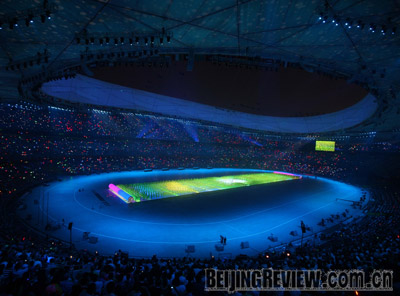 |
|
The opening ceremony of the Beijing Olympic Games, watched across the world on August 8, blends Chinese culture into a hi-tech show. [Beijing?Review] |
The opening ceremony of the Beijing Olympic Games on August 8 stunned the world, with its fascinating and glamorous art performance and visual effects. Many who witnessed the spectacular said it was like an epic movie, and of course, like many of today's blockbusters, it owed much to the use of cutting-edge technology.
The ceremony, featuring huge LED (light-emitting diode) screens, eye-catching lighting systems and inspiring multimedia video shows, involved dozens of advanced technologies, including materials for spaceships, according to Yu Jianping, head of the technology group for the opening ceremony, who led a 500-strong team of experts.
"The technology used at the Games' opening ceremony was some of the most complicated in history," Yu said, describing the gala as a perfect combination of advanced technology and great originality.
For example, at the top of the National Stadium where the opening ceremony was held is a 147-meter-long, 22-meter-wide LED screen, one of the biggest in the world. There was also a 36-meter-long, 30-meter-wide structure, with a total of 11 separate elevated platforms.
From the elevated platform to the video system, the creation team had worked hard to ensure that the whole ceremony went without a hitch.
"Since all of the facilities were completed on June 10, we had only two months to tackle any problems," said Yu, who is also the deputy designer of Shenzhou 7, China's third manned spacecraft that is expected to enter orbit in October.
"We are living in a hi-tech time and I think to present China's ancient culture through high technology is a more effective way to attract the young generation," said Zhang Yimou, Chief Director of the opening ceremony and a renowned Chinese filmmaker.
On Yu's initiative, state-of-the-art technology was introduced into many aspects of the ceremony. Apart from the huge LED screen and elevated platform, the globe that rose up at the end of the art performance was another highlight.
With a diameter of 18 meters, the globe weighs around 16 tons and can be raised to a height of 24 meters. A total of 58 stunt men performed on the globe, with half of them upside down part of the time.
"It was the first time such a huge globe was used in China," Yu said. "The material on its surface was a kind of flexible aluminum."
Their other creations included a huge scroll, 20 mm thick and weighing around 0.8 kg, and a digital direction and control system.
"Apart from the communications system, all of the technology we used was developed by local companies," Yu said.
Another impressive feature of the ceremony, the fireworks show, was also technology-intensive. "We have made breakthroughs in dynamic firework graphics technology, which can help us create certain shapes of fireworks in the air," said Zhao Jiayu, a technician with the ignition team of the opening ceremony.
Chinese elements
The opening ceremony of the Beijing Olympics featured many Chinese cultural elements, including the four great inventions of ancient China: papermaking, movable type printing, the compass and gunpowder.
Papermaking, one of China's special contributions to the spread and development of human civilization, was represented at the ceremony with a Chinese painting scroll that covered the center of the stadium and served as the platform for most performances.
The performance showing movable type printing used images of both ancient characters and a modern computer keyboard. Movable type printing began with the engraving printing of the Sui Dynasty (581-618). Bi Sheng of the Song Dynasty (960-1276), who is believed to be the first ancestor of printing, improved the process by making baked clay into movable characters for typesetting printing; thus he accomplished a significant revolution in printing history.
The compass was introduced to Europe in the 12th century. Its application to navigation resulted in Christopher Columbus's voyage to the New World and Ferdinand Magellan's circumnavigation. In the performance focusing on the Silk Road, an important passage for East-West economic and cultural exchanges, a dancer held an ancient compass in his hand.
Gunpowder was represented in the fireworks show. It was invented in the Song Dynasty (960-1276). It is the mixture of potassium nitrate, sulfur and charcoal-elements that people took as medicine in ancient times, hence the name "huoyao," which in Chinese means "burning medicines."
Other Chinese elements included an instrument called fou, a pottery wine container that can be struck with sticks to produce a musical sound. Taiji, a popular martial art, was also part of the ceremony.
(Beijing Review August 21, 2008)